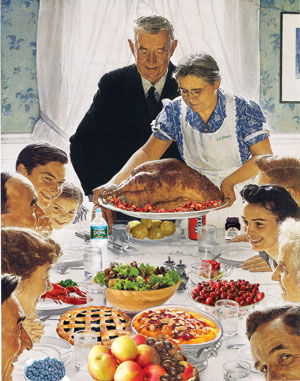November 2013 | view this story as a .pdf
Forget the frozen butterball this Thanksgiving and go locavore. Hunting and gathering the fresh and native is much more fun.
Hungry Eye
By Claire Z. Cramer
 We live in the best of times here for the renaissance of a traditional, locally raised and grown, genuine Thanksgiving. We can recreate the gourmet version of the Pilgrim experience, as if those wilderness decades of green bean casseroles with canned cream of mushroom soup, marshmallow-capped yams, and frozen Midwestern birds never happened.
We live in the best of times here for the renaissance of a traditional, locally raised and grown, genuine Thanksgiving. We can recreate the gourmet version of the Pilgrim experience, as if those wilderness decades of green bean casseroles with canned cream of mushroom soup, marshmallow-capped yams, and frozen Midwestern birds never happened.
Maine has been on this food throwback kick for about 20 years, but these days it’s really in high gear. Free-range and organic turkey farms such as Wolfe’s Neck Farm in Freeport, Frith Farm in Gorham, and Valley View Farm in Auburn sell their birds directly; the Rosemont markets and Pat’s Meat Market have them for order, and so do some of the farmers at the farmers’ markets. Autumn farmers’ markets are full of earthy root vegetables and greenhouse greens. The time for a locavore adventure is ripe.
Start with cranberries. Despite the fact that they are a native species people have always hand-picked in the wild, Maine’s first modern harvest didn’t occur until 1991. Back then, only 40 acres of cranberries were washing around in bogs here. Then-Governor King’s administration seized upon the idea of a cranberry industry as a way to revitalize economically depressed Washington County. This idea–great on paper–resulted in more than 200 acres of new vines being planted on small farms, but it took up to five years for new vines to mature, by which time the wholesale price for wet-harvested berries (the flooded bogs) had dropped significantly, reducing the original bright business model to a barely break-even prospect. Wet-harvested berries used for juice and canned sauce make up 95 percent of the U.S. cranberry business. The other five percent are sold fresh in markets. “All fresh cranberries sold in stores are dry-harvested,” says Nan Bradshaw of Bradshaw’s Cranberry Farm in Dennysville. “We sell our fresh berries to markets and farm stands, and we have a good mail-order business all over the country. The wholesale price for dry-harvested berries is much higher.” But the market is smaller. The Bradshaws commit one of their four acres to fresh dry-harvested berries, and wet-harvest the other three.
In Portland, it’s easy to opt out of the Ocean Spray empire and buy local. The Rosemont markets feature fresh Maine berries, as well as some stands at the farmers’ market; Hannaford stocks them from Ricker Hill Orchards in Turner.
Side dishes, from scratch
Chalk up a “recently local” success story for sweet potatoes. Once strictly a Southern crop, the vitamin-rich tubers have joined other warm-climate exotics like artichokes, poblano peppers, and okra in the bins of some Maine farmers’ market stands. “These Beauregards have a shorter growing season; we’ve been growing them for a couple of years,” said Wanda Snell at Snell Family Farm’s stand at the market. Our farmers keep finding ways to broaden our horizons.
OK, on to the mashed potatoes. “Maine potatoes” are not a monolithic entity–you’ve got to commit. Endless varieties–Gold Rush russets, golden-fleshed Desires, Early Ohios, Yukon Golds, Red Norlands, fingerlings, Magic Mollys, and Irish Cobblers–are grown in Maine soil.
“I like the red-skinned for mashing,” says Carolyn Snell.
“For mashing? Red-skinned,” says Bruce Hincks at the Meadowood Farm stand. “They have a creamy quality.”
“Oh no. Yukon Golds,” insists an eavesdropper who is picking through Hincks’ garlic bulbs.
You can mash up your favorites with Kate’s Homemade Butter from Old Orchard Beach and some Oakhurst or Smiling Hill Farm milk. Talk about terroir.
And squash? There’s a world beyond acorns and butternuts with names like Gill’s Golden Pippin, Paydon Golden, Carnival, and Sugar Dumpling.
To round out your side dishes, look for hardy local winter greens–brussels sprouts, broccoli, and ever more kinds of kale. Portuguese and Olde English kales with round, flat leaves appeared this fall alongside the Lacinato and Russian types that dominated the summer. In the market, source these from Stonecipher, Green Spark, Snell, Rippling Waters, and Freedom farms’ stalls.
First-course flash
Don’t forget about seafood, one of the best food traditions the early settlers learned from the native inhabitants. Baking shucked oysters (try Glidden Points or Pemaquids from Damariscotta, Dodge Coves from Hog Island, or Flying Points from Cousins River) in a gratin dish with lots of butter and bread crumbs is a simple and rich first course sometimes called “oyster dressing.” Creamed finnan haddie has old-time charm. So does salt cod–fancy it up by whipping it into a spread to put out with crackers and a selection of Maine cheeses before the meal. Harbor Fish has salt cod for $9.99 a pound.
Maine’s grains gain ground
You can buy a beautiful loaf or rolls from your local bakery and check that off your list. But if you want to get serious about an old-fashioned, exhausting, from-scratch Thanksgiving, consider making bread yourself–with Maine flour. Farmers in Aroostook County are growing wheat, oats, buckwheat, and rye to be milled into small batch flour. Borealis Breads was an early trendsetter collaborating with Maine farmers for a flour supply. The Borealis Cafe on Ocean Avenue in Portland sells bags of Aroostook whole wheat flour as well as assorted loaves made with it. “We also get some rye flour and sometimes spelt from Morgan’s Mills in Union,” says Borealis owner Jim Amaral.
In a converted downtown Skowhegan jailhouse, Amber Lambke and Michael Scholz of the Somerset Grist Mill are milling Maine wheat and oats, which natural foods distributor Crown of Maine delivers to such retail outlets as natural foods stores, the Rosemont markets, and Portland’s Whole Foods. “We’re also milling small quantities of barley, buckwheat, and emmer wheat into flour,” says Lambke. “We’re just getting into a heritage hard red wheat called Red Fife, prized for its sweetness and red tinge. It makes great crackers. And we mill flint corn into polenta and grits.” She adds, “Scratch Bakery in South Portland makes a sourdough loaf with our flour, and Standard Baking uses our flour in their Maine Miche loaf.”
The Miche is a flavorful brown peasant round worthy of your attention. “We make Miche loaves every day,” says Sara Deane at Standard Baking Co. on Commercial Street “It’s 100-percent Brio hard wheat, which is a Maine variety that Somerset mills for us. We also have a sourdough Maine Grain loaf, which contains the cracked grain of corn, rye, oat, wheat, and spelt grown in Aroostook by Wood Prairie Farm.”
Steaming cylindrical Yankee brown bread loaves made with cornmeal and molasses would be an old-time, messy, and fun home project. But you can simplify things and still honor Maine tradition by picking up a sack of Bouchard’s Ploye Mix at Hannaford and making griddle breads–the mix is made with Aroostook rye, and it’s as Franco-American Maine as it gets.
Don’t forget the stuffing. Homemade really counts here. Pay homage to the early settlers and Native Americans with the addition of crumbled corn bread, walnuts, dried fruit, or sage. If you want to be decadent about it, consider crumbled sausage meat, because Maine-made sausages are so easy to find and so tasty. Those made by big operations like Pineland Farms in New Gloucester and Mailhot’s in Lewiston can be found in supermarkets. In Portland, there are fresh sausages everywhere: the Fresh Approach market on Brackett Street, Pat’s Meat Market on Stevens Avenue, and the Rosemonts, to name three.
What to quaff
“This one’s unique,” says wine manager Chris at RSVP on Forest Avenue. “It’s Maine wine made with grapes actually grown in Maine.” Maine Coast White is a blend of cold-climate white grapes grown at Maine Coast Vineyards in Falmouth. “I’d call it an off-dry white; it’s very good, not sweet.” At $12.49, it’s certainly a good deal.
From Bartlett Vineyards in Gouldsboro, there are Coastal White and Coastal Red; Younity Winery in Unity produces “Tickled Pink” cranberry wine. Blacksmith’s in Casco makes a raspberry dessert wine. There are now 23 wineries in Maine.
How about beer? “What’s not made in Maine? It’s everywhere–you can’t miss it!” There are special brews for autumn: Peak Organic’s Fall Summit ale, Baxter Brewing’s Hayride Autumn ale, Shipyard’s Pumpkinhead, and Maine Beer Company’s Mean Old Tom Stout are just a few.
On to the pies
Excellent pie-pumpkin varieties are differentiated from the jack-o-lantern kind at the farm stand, so you really can do this from scratch without that can of orange puree. And anyone can make an apple pie. A single cookbook like The Joy of Cooking can walk you through Thanksgiving if you’re feeling timid.
But if you just aren’t a cook, fear not. There’s never been a better time to be a lazy locavore. There are so many Mainers committed to sourcing things locally for you. There are bakeries–Standard, Two Fat Cats, Borealis, Foley’s, Katie Made–who will make your local bread and dessert for you, and markets–Aurora Provisions, the Rosemont–to prepare all sorts of side dishes.
Or you can make reservations someplace fabulous and committed to local farmers, growers, and producers–like 555 in Portland or Sea Glass in Cape Elizabeth, for instance. Let them bring Maine to your plate.





0 Comments